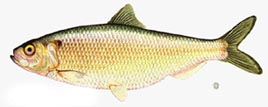Numerous fish undergo some form of migration which is usually for feeding or breeding purposes. Migration can be daily or annual, and range from several meters to great distances. There are several types of migratory fish, and the kind we’re describing here are called diadromous fish. These are fish that travel between salt and fresh water. These are some of our most ecologically and economically valuable species, like blueback herring, Atlantic striped bass, American shad and American eel. To keep 'em comin' back, you need to know where their preferred streams are. A list of these sites is maintained by CT DEEP's Marine Fisheries Program.
What is it?
There are three types of diadromous fish (fish that travel between salt and fresh water):
Anadromous fish live most of their adult lives in salt water, migrating to freshwater to breed. After the eggs hatch, the young fish spend varying lengths of time in freshwater before migrating to saltwater where they mature. The fish eventually return to freshwater to spawn. Only one percent of all fish in the world are anadromous; these fish undergo physiological changes that allow them to survive as they move between fresh and salt water. On the east coast, anadromous fish include river herring (American shad, alewife and blueback herring), Atlantic striped bass, Atlantic salmon and shortnose sturgeon.
Catadromous fish live in fresh water and migrate to salt water to breed. An example of a catadromous fish is the American eel.
Amphidromous fish move between salt and fresh water during their lives, but not for breeding purposes.
Climate Change and Migratory Fish Runs
Streams used by migratory fish may be subject to climate change impacts. These streams need to maintain suitable water flow and water temperatures. Changing precipitation patterns, drought, increases in stormwater and pollution and higher average air temperatures will all impact water quality and quantity. Maintaining vegetated riparian buffers along these stream corridors is one adaptaton solution that will help maintain the quality of streams. Researchers at the University of Connecticut are studying alewife and stream flow to calibrate models. These models will be used to look at potential climate scenarios and impacts to fish migration.
Why are They Important?
These fish are important to the aquatic food chain; they are preyed upon by other fish, as well as provide food for birds and other animals. In addition, a single female may produce up to 200,000 eggs, only a few of which survive to maturity; the rest become food for other species. Some anadromous fish species are also harvested as bait fish.
| Species: Alewife and Blueback Herring Although similar in appearance, the alewife (Alosa pseudoharengus) has a larger eye, is gray-green and is usually longer than the blueback herring (Alosa aestivalis). The blueback herring is blue-grey. Both fish have a prominent dark shoulder spot, and the females are larger and heavier than the males. |
|
|
|
|
Links
Fact Sheets from the Atlantic State Marine Fisheries Commission
For Citation Purposes: Connecticut Sea Grant & University of Connecticut’s Center for Land Use Education and Research. (October 20, 2016). Migratory Fish Runs. https://climate.uconn.edu/habitats-resources/coastal/fish-runs

